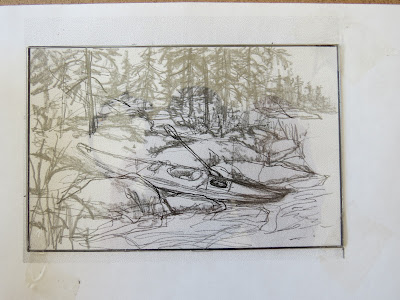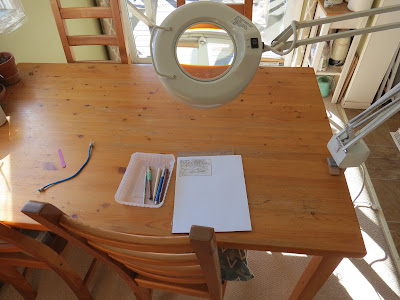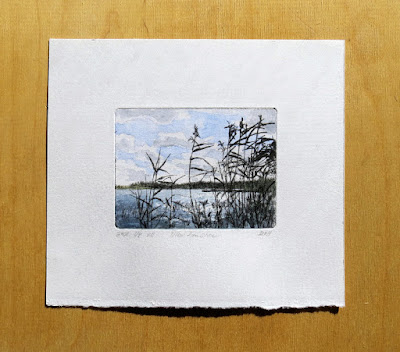 |
Nuthatch
relief block engraving w/ hand colour
printed image size: 5.5 x 8.25 cm |
While still "in the creative moment" from the previous post linocut endeavor I took another sketch of a nuthatch and decided to adapt it onto a small scrap piece of hard linoleum.
Due to the small size of the work and to help put less pressure on my neck I again used a illuminated swing-arm magnification lamp and a small portable table-top raised surface to cut the block on while I was sitting.
 |
permanent black marker drawn over pencil & cutting of surface areas underway |
 |
carved block ready to be printed ink was rolled across the surface with a small hard brayer |
The block size measures 2 1/8 x 3 1/4 inches, I found working with magnification really helped me see the cutting up close. It isn't until the relief surface is inked and the first progress proof is made that you get a sense of how small the line is in this.
I used a couple of blades to achieve the design. The first was a small u gauge liner blade which was used mainly for cutting and clearing away larger areas found in the bird and also in a couple of branches. To get the really fine line of the needles, lines in the feathers on the nuthatch I used a lozenge graver wood engraving tool.
Additionally, I found it better to have the linoleum cold and hard surface for cutting using the wood engraving tool.
When I had the block ready I rolled thinned oil base relief printing ink (in this case some older tube Daniel Smith relief carbon black).
I used my homemade registration board system with a 3 hole punch attached at the top to hold the paper, an L shaped mat board corner to hold the block in place and centered with the paper. I also had strip runners of 3/8 inch wide scrap lino glued to the sides of the registration board that would help keep the roller level and that the pressure was evenly distributed across the surface when the works are passed under it. Once the paper is attached to the board using the punch pins at top I set a piece of smooth masonite over top and carefully pass the works under the roller by turning the manual press levers.
I printed the first couple of inked block impressions on newsprint to help in adjusting the pressure of the roller, then a couple were made onto thin white kozo.
A small number were then printed onto Magnani and Somerset rag. Several were printed on 5 x7 inch card size rag (Arches) as I saw the opportunity to use these as my seasonal card for several close family and friends.
I allowed several days for the ink to dry by hanging the prints in a warm ventilated room.
A small amount of colour was introduced to the prints using fine artist grade watercolour paint with small sable brush.
It has been great to get back into relief printing and the processes involved.
Some of these will soon be listed as available in my Etsy shop found under my shop name Borealart. (link below)






























